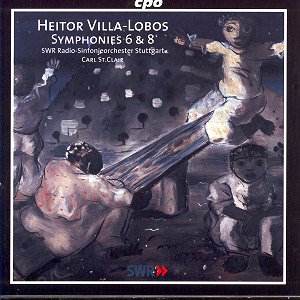Discs like this one only go to prove how much worthwhile music written by well-known figures of the twentieth century there is still to discover. The German-based CPO label sees the exploration of musical byways as its raison d'être and the SWR Radio-Symphony Orchestra, Stuttgart under Carl St. Clair is obviously stimulated by the opportunities offered.
Programme notes are extensive and help to fill in the background. There are various influences on Villa-Lobos's musical language, although all are subsumed under one vast, Brazilian umbrella: traces of Stravinsky vie with the exquisite bitter-sweet, polytonal harmonies of Darius Milhaud, and there is a French Impressionist's sensitivity to orchestral tone-painting.
Villa-Lobos's output includes a total of twelve symphonies written between 1916 and 1957, basically his entire creative life (it is a mouth-watering thought that there are also seventeen string quartets). The Sixth Symphony has particularly interesting theories behind its compositional methods, in which Villa-Lobos takes the contours of a mountain range (in this case the 'serva dos órrgãceos' of Rio) and translates them into melody. On paper, it sounds almost too extra-musical a genesis to bear musical fruit of substance, but Villa-Lobos's astonishingly fertile imagination means that the aural result is consistently fascinating (if not, in the final analysis, uniformly inspired).
Villa-Lobos's frequent unpredictability, both in harmony and rhythm, keeps listeners very much on their toes. The characteristic syncopation of the first movement of the Sixth is infectious, but it is the second movement which reveals (possibly) unexpected profundity. Marked 'Lento-Adagio', this is barren night-music: Bartók with a South American tinge. Some of the scoring is magical, as when trumpets cut through a sheen of high violins.
The weakest part of the symphony, unfortunately, is the last movement, predominantly diffuse at first, then degenerating into a John Williams-like film score. It is not so weak, however, as to banish recollections of the preceding movements and certainly not weak enough to prevent exploration of the next work on the disc.
The Eighth Symphony (1950) was premiered in 1955 by the Philadelphia Orchestra conducted by the composer. The programme notes state that 'the first theme ... has been erroneously identified by some as a quotation of the first theme of Schubert's Ninth Symphony'. Actually, intended or not, the connection is almost impossible to ignore, so, in effect, what happens is that Schubert is taken on a holiday to more exotic climes. This first movement is characterised by some winningly 'warm' harmonies and some happily jolly ones.
The second movement was the best received of the four at the premiere, and it is easy to hear why. It is delicate, evocative and darkly perfumed, the perfect foil for the scherzo (whose perilous difficulties do stretch the Stuttgarters somewhat). The finale is substantially more successful than the corresponding movement of the Sixth, maintaining its duration by means of unpredictability and playfulness.
The French title 'Suite pour cordes' was actually bestowed by Villa-Lobos's Parisian publisher, Max Eschig. A cursory glance at the contents of this disc might mean that one should be forgiven for not bothering: after all, you bought it for the symphonies, didn't you?. But appearances can be deceptive.
This is a much earlier work, dating from 1912/13. 'Timide' is the marking for the first movement, which effectively begins with a sigh. The word tender might perhaps sum up this movement as a whole. St Clair elicits excellent results from his players in this piece, where the warmth of the recording really helps. Perhaps the second movement is cast too much in the same mould as the first. The last movement, subtitled 'Air de ballet' is indeed graceful and dance-like, but it is the first which remains in the memory.
A superb disc, then, and one which I cannot recommend highly enough.
Colin Clarke

![]() SWR Radio-Symphony Orchestra,
Stuttgart/Carl St. Clair.
SWR Radio-Symphony Orchestra,
Stuttgart/Carl St. Clair.![]() CPO 999 517-2 [69.20]
CPO 999 517-2 [69.20]